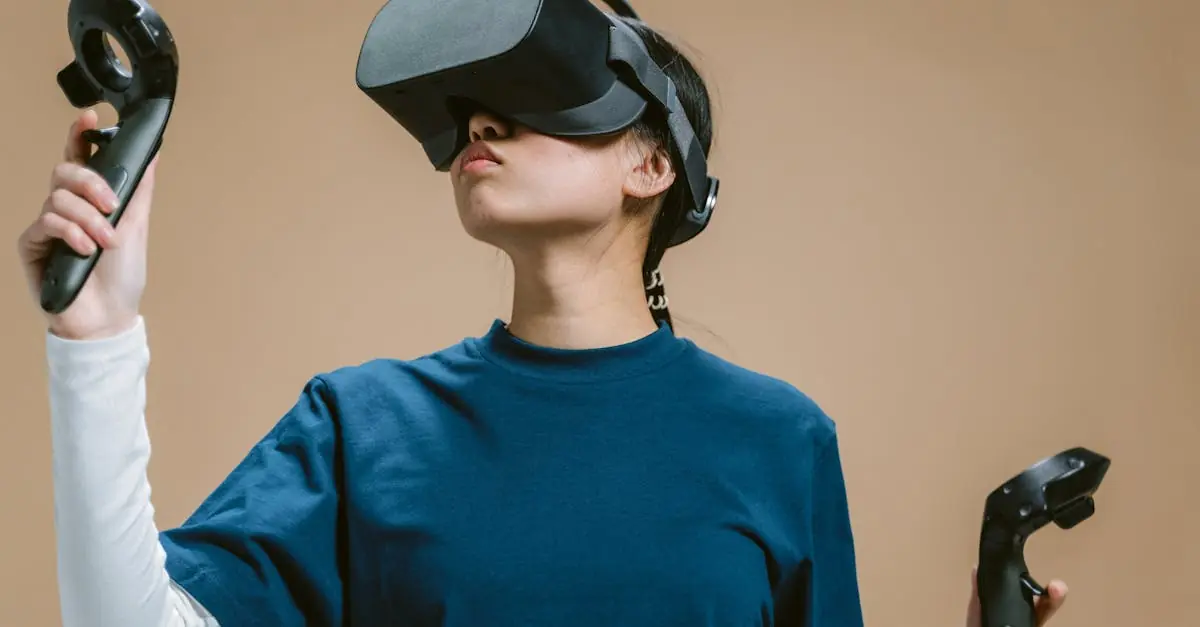In a world where technology evolves faster than a cat meme goes viral, two heavyweights are stepping into the ring: AI and augmented reality. Imagine AI as the brainy genius who can analyze data at lightning speed, while augmented reality is the flashy magician, blending digital wonders with the real world. These two titans are not just competing for your attention; they’re reshaping how we interact with everything around us.
Table of Contents
ToggleOverview of AI and Augmented Reality
Artificial intelligence and augmented reality play significant roles in technological advancement. Each technology enhances human experiences in unique ways.
Definition of AI
Artificial intelligence refers to computer systems designed to perform tasks that typically require human intelligence. Tasks include recognizing speech, making decisions, and solving problems. Algorithms analyze data, learning from inputs to improve their responses. A variety of applications exist, from virtual assistants like Siri and Alexa to complex systems in healthcare and finance. Businesses leverage AI to enhance customer service, optimize logistics, and predict market trends. Innovations continue to emerge, reshaping industries and driving efficiency.
Definition of Augmented Reality
Augmented reality combines digital elements with the real world, enriching user experiences. It overlays graphics, sounds, and other sensory enhancements onto physical environments. Applications range from gaming, with Pokémon Go, to practical uses in education and training. Professionals in fields like architecture and engineering utilize AR for visualization purposes, improving collaboration and design accuracy. This technology transforms how people interact with their surroundings, providing immersive experiences that enhance understanding and engagement.
Key Differences Between AI and Augmented Reality
Understanding the key differences between artificial intelligence and augmented reality clarifies their unique roles in technology. Each operates on distinct principles and affects user experiences in varied ways.
Technology Foundations
Artificial intelligence comprises algorithms that enable machines to perform tasks requiring human-like intelligence. These algorithms process vast amounts of data, learning patterns, and making decisions. In contrast, augmented reality relies on hardware and software to overlay digital information onto real-world environments. AR uses cameras and sensors to enhance physical spaces, allowing users to interact with both digital and physical elements seamlessly.
Application Areas
AI applications span various sectors, from virtual assistants like Siri and Alexa to data analysis in healthcare and finance. These systems optimize decision-making processes and improve customer experiences. Augmented reality, however, finds its strength in enhancing user engagement. Popular applications include immersive gaming experiences like Pokémon GO and educational tools that provide interactive learning experiences in subjects like history and science. Both technologies, while distinct, play complementary roles in reshaping interactions and experiences across numerous fields.
Benefits of AI and Augmented Reality
Both artificial intelligence and augmented reality offer numerous advantages that significantly enhance user experience and efficiency.
Advantages of AI
- AI improves efficiency by automating repetitive tasks.
- It enhances decision-making through data analysis and predictive modeling.
- AI personalizes user experiences, making recommendations tailored to individual preferences.
- It increases productivity in industries like healthcare and finance with automated processes.
- Businesses benefit from cost reductions as AI streamlines operations.
Advantages of Augmented Reality
- AR enriches real-world experiences by overlaying digital information.
- Users engage more deeply with educational content through interactive simulations.
- It enhances training programs, allowing professionals to practice in realistic environments.
- AR improves customer engagement in retail by visualizing products in real time.
- Industries like architecture visualize designs directly within their environment.
Challenges in AI and Augmented Reality
AI and AR face unique challenges that impact their advancement and adoption. Ethical considerations arise as both technologies grow, particularly in privacy and data security. Users often question how data collected by AI and AR systems might be utilized or misused. Transparency in data usage builds trust, though achieving this often proves difficult.
Technical limitations also hinder progress in these fields. AI requires vast datasets for training, and these datasets must be representative to avoid biases. Augmented reality, while immersive, relies on hardware compatibility and processing power. Device performance can significantly affect user experience, making it crucial for developers to optimize applications for various platforms. Both AI and AR rely on continuous innovation to overcome these obstacles and remain effective in their respective roles.
Future Trends in AI vs Augmented Reality
AI and AR are evolving rapidly, influencing various sectors and enhancing user engagement. As these technologies progress, their potential impacts on daily life and industries become increasingly significant.
Innovations in AI
AI innovations focus on refining natural language processing and machine learning algorithms. Enhanced chatbots now provide personalized customer support, demonstrating improved understanding of user intent. Companies leverage AI for predictive analytics, turning data into actionable insights that drive business strategy. The development of AI-driven automation tools increases productivity across industries, allowing staff to focus on higher-level tasks. Additionally, advancements in ethical AI practices prioritize transparency, fostering trust in automated decision-making.
Advancements in Augmented Reality
AR advancements center on improving hardware capabilities and software integration. Current headsets and mobile devices offer more immersive experiences, bridging physical and digital environments seamlessly. AR applications in education help students visualize complex concepts, making learning more engaging. Retailers utilize AR for virtual try-ons, allowing customers to experience products before purchase. Integration with AI enables more interactive and personalized experiences, combining data insights with real-world contexts to enhance user satisfaction.
The intersection of AI and AR is shaping the future of technology in profound ways. As they continue to evolve they promise to enhance user experiences and transform industries. While AI streamlines processes and optimizes decision-making AR captivates users by blending digital elements with reality.
Both technologies face challenges that require ongoing innovation and ethical considerations. As developers strive to create seamless integrations between AI and AR the potential for personalized and immersive experiences grows. This synergy not only enriches everyday interactions but also sets the stage for advancements that could redefine how people engage with technology in the years to come.



